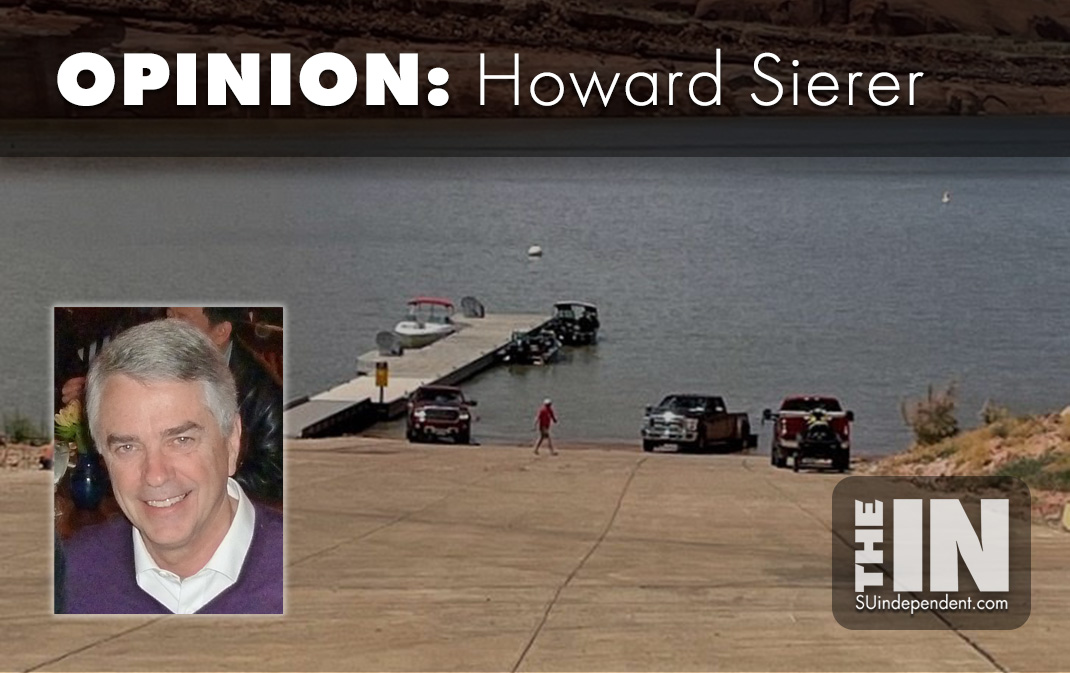
Water Conservation Programs: One in Progress, Two to Go
– By Howard Sierer –
In a 2021 column titled “The End of the Lake Powell Pipedream,” I cheered the inevitable demise of the Washington County Water Conservation District’s multi-billion dollar plan to promote urban sprawl across our magnificent landscape. I backed up my pipeline opposition with other columns that recommended several workable pipeline alternatives, one of which is being implemented today.
I applaud the WCWCD’s “Lazy Grass” turf replacement initiative, known officially as its Water Efficient Landscape Program. The district is rightfully proud of replacing about 1.6 million square feet of water-wasting grass with xeriscaping. The district points out that grass uses up to four times as much water as more appropriate desert landscaping whose plants are irrigated with dripper systems.
Funding for the program is provided by the state with Washington County by far the star pupil. The state’s other three water conservancy districts combined have removed less grass than we have here in Washington County. Being fair to them, our climate is a powerful motivator.
The Lazy Grass program is not finished and I join the district and the environmental group Conserve Southwest Utah in encouraging all homeowners with lawns to take advantage of the state’s largesse and replace their water-thirsty grass.
There are two more steps to go that would allow Washington County and the state as a whole to put the state’s water to its most productive uses. First, motivate our heaviest water users to become more mindful of the amount of water they are using. Here’s how.
In 2020, I gave the City of St. George credit for taking “A Baby Step Toward Conservation” when it raised water rates for its heavier users while leaving rates unchanged for moderate users. But I was disappointed that the city didn’t follow the Tucson, AZ, example of dramatically higher rates for those heavy users. Example: St. George now charges $125.47 for those using 60,000 gallons per month. Tucson charges $623.13 for that much water.
I applaud giving those heavier users a choice about their water use but, analogous to progressive income tax rates, I believe those putting the greatest demands on our water sources and infrastructure should bear a disproportionately higher share of the cost. Washington County and all its cities should follow Tucson’s example.
The third and final conservation step available to us was explained in my column surprisingly titled “Utah Will Never Run Out of Water.” Our state’s farmers and ranchers generate less than 1% of our state product, employ 2% of our workforce, yet use 82% of our water. While some of that water is used to produce locally-grown food and dairy products, a stunning 68% of our state’s water is used to irrigate alfalfa, a water-intensive crop that represents a minuscule 0.2% of our economy! And a significant fraction of that hay is exported to China, of all places.
We don’t have a statewide shortage of water; instead, we have to make decisions about how to use the water we have.
I believe it’s time for Utah to create a free market in water, one that allows farmers and ranchers to sell portions of their water rights to county and municipal water supply agencies without losing the balance of those rights. When they see that their water really is a marketable asset, water rights holders could make rational and cost-effective choices about which crops to raise, how much to plow (pun intended) into more efficient irrigation methods, or whether to abandon farming completely.
So get rid of your lazy lawn and as soon as you do, encourage your city council to adopt water rates like Tucson’s that will extend our existing water supplies well into the future. Nonetheless, we all need to recognize that the day is coming in the not-too-distant future when population growth in our water-scarce desert environment will approach its limit. Then we will have to answer the question posed in yet another column: “How Many People Do You Want Here?”



